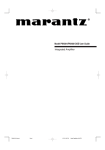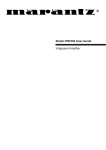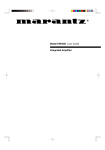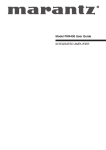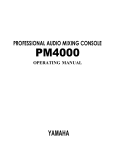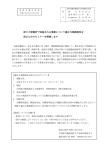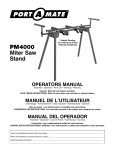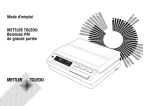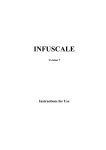Download Marantz PM4000 Stereo Amplifier User Manual
Transcript
Model PM4000 User Guide INTEGRATED AMPLIFIER 1 ABOUT THIS USER GUIDE Refer to the Figures on the pages at the rear of this user guide. The callout numbers on the Figures correspond to those found in the text. All references to the connections and controls that are printed in BOLD type are as they appear on the unit. This section must be read before any connection is made to the mains supply. English WARNINGS PRECAUTIONS Do not expose the equipment to rain or moisture. The following precautions should be taken when operating the equipment. Do not remove the cover from the equipment. Do not push anything inside the equipment through the ventilation holes. GENERAL PRECAUTIONS When setting the equipment ensure that: — the ventilation holes are not covered — air is allowed to circulate freely around the equipment — it is on a vibration free surface — it will not be exposed to interference from an external source — it will not be exposed to excessive heat, cold, moisture or dust — it will not be exposed to direct sunlight — it will not be exposed to electrostatic discharges In addition, never place heavy objects on the equipment. If a foreign body or water does enter the equipment, contact your nearest dealer or service center. Do not pull out the plug by pulling on the mains lead, hold the plug. It is advisable when leaving the house, or during a thunder-storm, to disconnect the equipment from the mains supply. Do not handle the mains lead with wet hands. EQUIPMENT MAINS WORKING SETTING Your Marantz product complies with the household power and safety requirements in your area. “N”or “UK” Version product can be powered by 230 V AC only. IMPORTANT: This apparatus is fitted with an approved moulded 13 Amp plug. To change a fuse in this type of plug proceed as follows: 1. Remove fuse cover and fuse. 2. Fix new fuse which should be a BS1362 5A, A.S.T.A. or BSI approved type. 3. Refit the fuse cover. If the fitted plug is not suitable for your socket outlets, it should be cut off and an appropriate plug fitted in its place. If the mains plug contains a fuse, this should have a value of 5A. If a plug without a fuse is used, the fuse at the distribution board should not be greater than 5A. NOTE: The severed plug must be destroyed to avoid a possible shock hazard should it be inserted into a 13A socket elsewhere. CONNECTIONS (Figure 1) CONNECTION OF TUNER Connect the output jacks of your stereo tuner to the TUNER jacks of this unit. CONNECTION OF COMPACT DISC PLAYER Connect the output jacks of your CD player to the CD jacks of this unit. CONNECTION OF TURNTABLE Connect the L (Left) output cord of the turntable to the “L” PHONO jack of this unit, and connect the R (Right) output cord to the “R” PHONO jack. Also be sure to connect the turntable’s grounding wire to the GND jack of this unit. The GND jack does not have to be connected if the turntable is not provided with a grounding wire. HOW TO CONNECT A PLUG The wires in the mains lead are coloured in accordance with the following code: BLUE—”NEUTRAL” (“N”) BROWN—”LIVE” (“L”) 1. The BLUE wire must be connected to the terminal which is marked with the letter “N” or coloured BLACK. 2. The BROWN wire must be connected to the terminal which is marked with the letter “L” or coloured RED. 3. Do not connect either wires to the earth terminal in the plug which is marked by the letter “E” or by the safety earth symbol or coloured green or green-and-yellow. Before replacing the plug cover, make certain that the cord grip is clamped over the sheath of the lead — not simply over the two wires. CONNECTION OF TAPE DECK Connect the IN (recording input) jacks of the tape deck to the TAPE OUT jacks of this unit, and connect the OUT (playback output) jacks of the tape deck to the TAPE IN jacks of this unit. CONNECTION OF SPEAKER SYSTEMS This unit is equipped with two sets of SPEAKER SYSTEM terminals––SYSTEM 1 terminals and SYSTEM 2 terminals. Usually connect your speaker system to the SYSTEM 1 terminals. ¡ The speakers in the speaker system should have an impedance between 8 and 16 ohms. If speakers with an impedance of less than 8 ohms are connected, the protection circuitry may be activated during play. ¡ Connect the Right channel speaker to the R terminals, and the Left channel speaker to the L terminals. ¡ The output terminals have positive (+: Red) and negative (–: Black) polarity, and each speaker also has the same polarity (+ and –). When connecting the speaker, be sure to connect the terminals with the same polarity (+ with +, – with –). COPYRIGHT Recording and playback of any material may require consent. For further information refer to the following: — Copyright Act 1956 — Dramatic and Musical Performers Act 1958 — Performers Protection Acts 1963 and 1972 — any subsequent statutory enactments and orders 4 English FOREWORD CONTROLS, CONNECTORS, AND INDICATORS English !4 q VOLUME CONTROL Adjusts the volume level. Turn the knob clockwise to increase the volume. PHONO INPUT JACKS Connect the output jacks of a turntable to these jacks. w GND (GROUND) TERMINAL Connect the grounding wire from the turntable to this terminal. !5 BALANCE CONTROL Turn the knob to correct an unbalanced program source such as stereo broadcast or to vary the output level of the left or right channel. Note that, if the BALANCE control is turned fully in one direction, the sound will not be heard from the speaker on the other side. e CD PLAYER INPUT JACKS Connect the output jacks of a Compact Disc player to these jacks. r TUNER INPUT JACKS Connect the output jacks of the tuner to these jacks. !6 LOUDNESS SWITCH The LOUDNESS switch compensates for human hearing characteristics by boosting the bass and treble response at low volume levels to achieve a more pleasing tonal balance. t AUX INPUT JACKS These are auxiliary input jacks which can be used to connect the audio outputs of AV components such as TV multiplex/stereo audio tuners, VCRs, and laserdisc players. !7 TONE DEFEAT SWITCH ¡ When the switch is not depressed, the audio signals are applied to the tone control circuit and the tone can be adjusted using the tone control knob. ¡ When the switch is depressed, the audio signals bypass the tone control circuit and the tone control knob does not function. y TAPE, CD-R/MD IN/OUT JACKS Connect the play (output) jacks and record (input) jacks of tape decks to these jacks. u SPEAKER SYSTEMS 1/2 TERMINALS Connect your speaker system(s) to these terminals. !8 BASS AND TREBLE TONE CONTROLS Adjusts the tone by controlling the levels of two frequency bands. Turn each control toward (+) to enhance the corresponding frequency band, or toward (–) to attenuate it. TREBLE: Adjusts the high frequency level. BASS: Adjusts the low frequency level. i REMOTE CONTROL BUS TERMINALS (REMOTE CONT. BUS) Another item of audio equipment with a remote control bus terminal can be connected to these terminals by using a specialpurpose cable. The bus OUT terminal is used to send signals to another item of equipment. The bus IN terminal is used to receive signals from another item of equipment. !9 REC SELECTOR SWITCH Selects the tape dubbing mode between tape decks or the signal output at the REC OUT jacks. o POWER CORD Connect to a household power outlet. @0 POWER SWITCH Pressing once switches the power ON, and pressing again switches it OFF. The POWER indicator lights when the POWER switch is ON, and go out when the POWER switch is OFF. SPEAKERS 1/2 SWITCHES These switches are used to select the speaker system(s) connected to the SPEAKER SYSTEM 1/2 terminals on the rear panel. If both the 1 and 2 switches are pressed to the low positions, two speaker systems can be used at the same time. When headphones are used for listening, set both switches 1 and 2 to OFF (high positions). !1 @1 !0 PHONES JACK Insert the standard phone plug of the headphones into this jack. REMOTE SENSOR The remote sensor receives the infrared commands from the remote control unit. When an infrared signal is received from the remote control unit. The remote control unit must always be pointed directry at the remote sensor. !2 INPUT SELECTOR Selects the program source to be recorded or played from the PHONO, CD, TUNER, AUX, TAPE, and CD-R/MD. !3 MUTING INDICATOR Light up when the MUTING button in the remote control unit is pressed. NOTE: Be sure to check the VOLUME control setting before pressing this switch to cancel muting. If the muting is canceled while the volume setting is high, the speakers could be damaged. 5 English (Figure 2) OPERATION PROCEDURES TAPE DECK OPERATION q A w INTEGRATED AMPLIFIER PM4000 INPUT SELECTOR VOLUME English PHONO CD TUNER TONE DEFEAT ON PHONES STANDBY SOURCE CD-RfiTAPE TAPEfiCD-R COPY TAPE VOLUME PHONO LOUDNESS TONE DEFEAT BASS TREBLE ON OFF REC SELECTOR OFF POWER ON/OFF AUX INPUT SELECTOR CD-R/MD MUTE ON OFF MIN 1 SPEAKERS MAX BALANCE POWER ON/OFF PHONES STANDBY CD SOURCE + ON OFF L BASS TREBLE ON OFF MIN SPEAKERS MAX BALANCE 2 AUX – REC SELECTOR Operate each equipment to start play. OFF 1 R e CD-R/MD LOUDNESS TUNER COPY – TAPE CD TAPEfiCD-R AUX AUX MUTE PHONO CD-RfiTAPE TUNER + TUNER REC SELECTOR OFF 2 PHONO – CD English INTEGRATED AMPLIFIER PM4000 B + – + ON OFF L R C Control used for operating the tape deck. TO PLAY AN ANALOG DISK TAPE PLAYBACK 1. Set the INPUT SELECTOR switch q to PHONO. 1. Set the INPUT SELECTOR switch A to TAPE or CD-R/MD. 2. Play a disk on the turntable. 2. Play a prerecorded tape on the tape deck. 3. Adjust the volume with the VOLUME control w and adjust the tone with the BASS and TREBLE controls e. 3. Adjust the volume with the VOLUME control B. 4. Adjust the tone with the BASS and TREBLE controls C. NOTES: ¡ Set the VOLUME control to the minimum position before placing the stylus on the disk or before replacing the cartridge. ¡ Do not apply shock or vibration to the turntable during play, as this may cause the stylus to jump and the analog disk to be damaged. ¡ If the turntable is installed too close to the speakers, the volume may not be able to be increased to a high level due to howling. ¡ Do not switch the power OFF while the stylus is on the disk surface. TAPE RECORDING The playback sound of a program source component, such as a turntable, a tuner, or a CD player, can be recorded on tape as follows. 1. Set the INPUT SELECTOR switch A to the program source to be recorded. 2. Play the program source. 3. Operate the tape deck(s) to record the playback sound on tape(s). TO LISTEN TO FM/AM BROADCASTS Using REC SELECTOR switch 1. Set the INPUT SELECTOR switch q to TUNER. REC SELECTOR OFF SOURCE 2. Tune in the desired station on the tuner. CD-RfiTAPE 3. Adjust the volume with the VOLUME control w and adjust the tone with the BASS and TREBLE controls e. TAPEfiCD-R COPY TO PLAY A COMPACT DISC PHONO CD TUNER AUX The REC SELECTOR switch is used when copying a cassette tape to another tape or recording a CD onto a cassette tape. 1. When the switch is in the OFF position, the signal is not output at the REC OUT jacks. It is not necessary to output the signal at the REC OUT jacks when the signal is not recorded onto tape. By setting the switch to OFF, the signal path inside the unit can be shortened and crosstalk, etc., can be reduced. 1. Set the INPUT SELECTOR switch q to CD. 2. Play a CD on the CD player. 3. Adjust the volume with the VOLUME control w and adjust the tone with the BASS and TREBLE controls e. TO PLAY A COMPONENT CONNECTED TO AUX JACKS The component connected to the AUX jacks on the rear panel can be played as follows. 1. Set the INPUT SELECTOR switch q to AUX. 2. In the SOURCE position, the signal selected with the INPUT SELECTOR switch can be recorded onto tape. 3. In the TAPE COPY positions, the TAPE signal can be recorded onto CD-R/MD or vice versa. 2. Play the component connected to the selected input. 3. Adjust the volume with the VOLUME control w and adjust the tone with the BASS and TREBLE controls e. 4. In the TAPE COPY position, the program source selected with the INPUT SELECTOR switch can be monitored through the speakers. 6 REMOTE CONTROL UNIT RC8000PM USING THE REMOTE CONTROL UNIT z 1. Remote control Operate the remote control unit within a distance of approx. 5 m from the infrared signal reception window (remote sensor) on the front of the Amplifier. Remote control operation may not be possible if the remote control unit's transmitter is not pointing in the direction of the remote sensor or if there is an obstruction between the transmitteote sensor. SYSTEM SOURCE ON OFF ON/OFF AMP PHONO CD TUNER CD-R AUX1 AUX2 TAPE MD 1 2 3 A, F/P 4 5 6 B, - / - - 7 8 9 MODE – 0 + MEMO x Remote control operating range Amplifier Approx. 5 m 1–MODE–2 SCROLL CANCEL TEXT TIME MUTE VOLUME UP OPEN/ CLOSE VOLUME DOWN v 60° c Remote control unit RC8000PM REMOTE CONTROL UNIT z 2. Loading batteries POWER ON/OFF Batteries in this remote control unit have a life of approximately 1 year under normal operating conditions. When the remote control unit is not to be used for an extended period of time, remove the batteries. Also, when you notice that the batteries are starting to run down, replace them as soon as possible. a. SYSTEM ON button The equipment of Marantz can be turned on at the same time in this button. (However, this operation is limited to the equipment of Marantz with the standby function.) (1)Remove the battery cover. b. SYSTEM OFF button The equipment of Marantz can be turned off at the same time in this button. (However, this operation is limited to the equipment of Marantz with the standby function.) Remote control unit Rear side c. SOURCE ON/OFF button After the AMP button is pushed, this button is pushed, the set is turned on and off. x c v FUNCTION SELECT button TUNER button : When this button is pushed the input of TUNER is selected. PHONO button : When this button is pushed the input of PHONO is selected. TAPE-1 button : When this button is pushed the input of TAPE is selected. MD button : When this button is pushed the input of MD/CD-R is selected. CD-R button : When this button is pushed the input of MD/CD-R is selected. AUX button : When this button is pushed the input of AUX is selected. (2)Insert batteries with correct + / – orientation. Two AA (R6)-size batteries VOLUME UP/DOWN button UP button : VOLUME knob turns when this button is pushed and the volume level is grows. DOWN button : VOLUME knob turns when this button is pushed and the volume level is falls. (3)Close the battery cover until it clicks shut. AUDIO MUTE button When this button is pushed, the sound is not temporarily emitted from the speakers. When this button is pushed again, MUTE is released. Moreover, when up/down of the volume is operated by remote control, MUTE is released. Other buttons are not applied to PM4000. Please see at the owners manual of other equipment’s about the operation of button. 7 English English The RC8000PM can be used to control a Marantz AV component equipped with a remote sensor as well as other Marantz components connected to the first component through the Remote Control Bus. The buttons of the RC8000PM are laid out on its control panel according to the functional groups as described below. TROUBLE SHOOTING This section describes the care and maintenance tasks that must be performed to optimize the operation of your Marantz equipment. In case of trouble or abnormal operation of the unit, check the following before contacting service personnel. What may seem to be a serious malfunction is often the result of a simple operation mistake. If the trouble persists after checking the following, please contact your dealer or nearest Marantz distributor. CLEANING OF EQUIPMENT EXTERNAL SURFACES The exterior finish of your PM4000 will last indefinitely with proper care and cleaning. Never use scouring pads, steel wool, scouring powders or harsh chemical agents (e.g., lye solution), alcohol, thinners, benzine, insecticide or other volatile substances as these will mar the finish of the equipment. Likewise, never use cloths containing chemical substances. If the equipment gets dirty. wipe the external surfaces with a soft, lint-free cloth. If the equipment becomes heavily soiled: — dilute some washing up liquid in water, in a ratio of one part detergent to six parts water — dip a soft, lint free in the solution and wring the cloth out until it is damp. — wipe the equipment with the damp cloth. — dry the equipment by wiping it with a dry cloth. The amplifier does not operate and the indicators do not light. 1. Check to see if the power cord is inserted properly into the power outlet. The indicators light but the amplifier does not operate. 1. Check to see if the SELECTOR,SPEAKER switches and VOLUME control are properly set. Sound is heard from only one of the speakers. 1. Check to see if the BALANCE control is properly set. 2. Switch the power of the unit to OFF, and change the connections of the left and right speaker cords. If the sound from the same speaker is still not heard, its connection cord or the speaker itself may be defective. REPAIRS Only the most competent and qualified service technicians should be allowed to service the equipment. The Marantz company and its factory-trained warranty station personnel have the knowledge and special facilities needed for repair and calibration of this precision equipment. After the warranty period has expired, repairs will be performed for a charge if the equipment can be returned to normal operation. In the event of difficulty, refer to your dealer or write directly to the nearest location to you that is listed on the Marantz Authorised Service Station list. If writing, please include the model and serial number of the equipment together with a full description of what you think is abnormal about the equipment’s behaviour. Considerable hum noise is heard when the turntable is played. 1. Check to see if the plugs from the turntable are properly connected to the PHONO jacks. 2. Connect the grounding wire of the turntable to the GND terminal on the rear panel of this unit. If it has already been connected, try removing it. 3. Check to make sure that the phono cartridge is attached securely to the tonearm. 4. Unplug the power cord and plug it in again after inverting the orientation of the blades. Remote control operation is not possible. 1. Is the remote control unit's transmitter pointed correctly at the remote sensor on the front of the Amplifier? Or, is there an obstruction between the transmitter and the remote sensor? 2. Are the batteries in the remote control unit exhausted? 3. Is there another strong light (from a window, etc.) striking the Amplifier remote sensor? 4. Is an RCA cord connected to the "REMOTE CONTROL IN" jack on the Amplifier rear panel? 8 English English CARE AND MAINTENANCE MODEL PM4000 TECHNICAL SPECIFICATIONS (DIN) Power output RMS 8 Ohms/4 Ohms (40 Hz – 20 kHz) .................................................................................................................................. 30 / 40 W DIN 8 Ohms / 4 Ohms ............................................................................................................................................................... 35 / 45 W IHF dynamic power 8 Ohms / 4 Ohms ..................................................................................................................................................................... 50 / 80 W THD at 8 Ohms RMS rated output .............................................................................................................................................. 0.005% Intermodulation distortion ............................................................................................................................................................. 0.005% Damping factor ..................................................................................................................................................................................... 80 Magnetic cartridge input Input sensitivity impedance ...................................................................................................................................... 2.5 mV / 47 k ohms Accuracy of frequency response to RIAA ..................................................................................................................................... 0.5 dB Signal to noise ratio ....................................................................................................................................................................... 80 dB Tuner / CD / Aux / Tape inputs Input sensitivity impedance ..................................................................................................................................... 150 mV / 20 k ohms Signal to noise ratio ..................................................................................................................................................................... 105 dB Frequency response (–1 dB) ............................................................................................................................................... 10 – 50 kHz Tone characteristic (100 Hz and 10 kHz) ....................................................................................................................................... –6 dB Channel separation ........................................................................................................................................................................ 70 dB General Power Requirements N, UK version ........................................................................................................................................................ 230 V AC, 50 Hz Dimensions (MAX) Width .................................................................................................................................................................................... 440 mm Height ................................................................................................................................................................................... 116 mm Depth .................................................................................................................................................................................... 293 mm Weight ............................................................................................................................................................................................ 6.0 kg Specifications subject to change without prior notice. 49 Tuner Turntable Tape deck INPUT OUTPUT OUTPUT GND SPEAKER SYSTEMS SYSTEM 1 : 4 -16 OHMS SYSTEM 2 : 4 -16 OHMS SYSTEM 1+2 : 8 -16 OHMS SYSTEM 2 R PHONO CD TUNER AUX CD-R/MD L TAPE L R IN OUTPUT OUT IN OUT R L SYSTEM 1 OUTPUT OUTPUT INPUT Tape deck CD player Analogur output jacks or AV components, video disc player, etc. SPEAKER SYSTEMS SYSTEM 1 : 8 -16 OHMS SYSTEM 2 : 8 -16 OHMS SYSTEM 1+2 : 16 OHMS 5 mm SYSTEM1 R L R L SYSTEM2 Loosen the terminal Inset the core Connection of speaker cable Figure 1 50 Tighten the terminal Model PM4000 N Version GND SPEAKER SYST EM S S Y S T EM 1 : 4 -16 OHMS S Y S T EM 2 : 4 -16 OHMS S Y S T EM 1 + 2 : 8 -16 OHMS ∼ SYSTEM 2 R PHONO CD TUNER AUX CD-R/MD REMOTE CONTROL L IN TAPE OUT L R IN OUT IN R OUT y qwe r t u !2 !0 L SYSTEM 1 o i !7 !3 !4 !6 INTEGRATED AMPLIFIER PM4000 INPUT SELECTOR VOLUME PHONO CD TUNER TONE DEFEAT ON PHONES STANDBY SOURCE LOUDNESS ON BASS OFF MIN TREBLE 1 SPEAKERS MAX BALANCE 2 PHONO CD TAPEfiCD-R TUNER COPY AUX – !1 CD-R/MD OFF CD-RfiTAPE @1 TAPE MUTE REC SELECTOR OFF POWER ON/OFF AUX + !9 – !8 Figure 2 51 + ON OFF @0 L R !5










